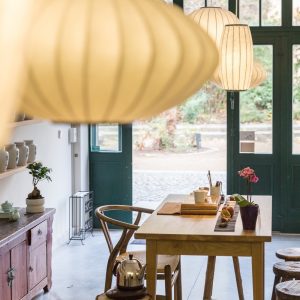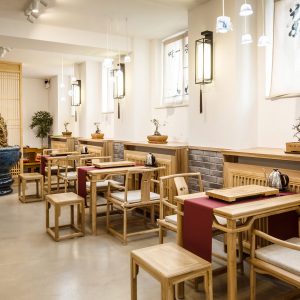Yancha Shuixian, Wuyi oolong
- Yancha Shuixian 岩茶水仙, or Rock Tea Water Lily, aka Sacred Lily, a variety of Wuyi oolong with a wide range of quality of styles 20052 | 8971 2007
- Bujiantian 不見天, a Wuyi Shuixian oolong 武夷山水仙
- Da Hong Pao, aka Big Red Cloak 大紅袍, a Wuyi oolong. 20054, 2007 | 8959
- Shuijin-gui 水金龜, a Wuyi Shuixian oolong 武夷山水仙。 T406 2005/6 | 8976
Better Wuyi oolong selections are collectively called Yancha 岩茶, i.e. tea from the big rock, meaning they are grown in the narrow terraces or tiny patches of land in between the giant dark rocks typical in the Wuyi region. Besides the Shuixian strand of cultivars, there are also the popular Rougui and Meijian strands, in addition to some lesser known Wulongs, Da’bai and Tieguanyin cultivars. We have discussed some basic facts about Shuixian 水仙 in the Tea Nature section Wuyi oolongs chapter, let’s further look at the variety here.
exquisite water goddesses
Whether or not you have heard of tea variety names as Da Hongpao 大紅袍 or Tie’luohan 鐵羅漢 or the likes, the price of such labels, if the product is genuine, is intimidating. The fact is, they are all from cultivars of the Shuixian strand. Their fame and price are results of much marketing hype and fame chasing.
This is not to diminish their gastronomic value of the teas, though. They are only some over-priced varieties of Wuyi Shuixian, and Wuyi Shuixian is worth the talk.
Shuixian, aka Shuisin, Water Goddess, Water Lily, used to be a popular restaurant tea variety before they are replaced by low quality Minnan Oolongs, due largely because of the rise in price.
A fine, matured Shuixian has a warm, woody aroma with hints of flora. Infused properly, it tastes round and quite long and deep, with each selection’s own floral, wood and/or nut accents. I would not describe the more expensive Da Hongpao or Tie’lohan any differently. <Read more about Wuyi Oolongs>
selection notes
Most production nowadays yield tea looking quite similar and it is hard to make any judgement without actually properly tasting a selection. Finer ones are not as frequent to come by since the traditional way of production is lost to higher margin and lesser skilled work. <Buying tips>
In any case, a freshly made fine Wuyi should have the above mentioned aroma and taste characters, except that there would be a slight over-baked carbon disturbance in the smell. It should be very slight — a burnt tea is not going to be a good tea. The taste would be a little too sharp and the astringency a little too prominent. However, anything over “a little” would be signs of an average quality selection. Pay attention to the length and pitch of the taste, they are the prospects of a fine tea. All these would subside upon aging to give depth and roundness. The accent(s) should be there and quite strong for holding through maturity.
tasting notes
Like all high-fired teas, a fresh or pre-matured Wuyi Shuixian does much better with the Yixing pot, which basically helps to harmonize all the taste and aroma elements of the tea. Use either basic infusion or gongfu infusion approaches.
As for matured teas, the Yixing pot does make a difference too. Do compare it with infusion using porcelain.
Shuixian is fine as a standalone drink for throughout the day. It is a most versatile food companion. When paired with dishes of stronger flavours, do make a stronger infusion.
health notes
As mentioned in the Wuyi oolong health chapter, Shuixian varieties are suitable teas for the weak and weak stomachs. It is particularly suitable for certain individuals during menstruation when most other teas — with the exception of certain truly post-fermented Puers, matured classic Phoenix oolongs, and matured high-fired Tieguanyin, — are going to upset the system.
However, there are in the market low-fired versions which may smell more bouquet but are really NOT the same as a genuine Shuixian. Stay away from those when you are not in a healthy condition.
When using Shuixian to help fight colds and flus, remember to use the gongfu infusion approach — a lot more tealeaves and short infusion time. Use only matured genuine Shuixian. To our experience, however, Shuixian is not as effective as Phoenix bouquet style varieties, which are also from the Shuixian strand of cultivars.
<Click here to read more about Phoenix oolongs; here to read more about the origin of Wuyi oolongs>
buying tips
Like most other fine teas, the market for Wuyi Shuixian is irregular, i.e. you may buy a better tea for the money from one dealer than another. Shop around.
The fact is, certain producers are not making the quality the corresponding grade/name used to represent. The worst situation is in famous varieties of Shuixian such as Da Hongpao, Tie’lohan, Baijiguan etc. Most in the market are imitations.
For the genuine products and the other not so famous, plainly-named Yancha Shuixians, the production quality fluctuates extremely variedly from farm to farm. Traditional production skills from the fermentation (zaoqing) stage all the way down to the baking stage are very casually done in most farms. Tourism in the Wuyi area and the teas’ names have allowed them a demand that they feel they can ask a good price anyway. That is the case for those with direct sales channels. Those farmers without do need to operate in a different condition — they need to compete. Hopefully all will need to go back into the competition for better value offer for better business mindset soon. For the benefits of all.














